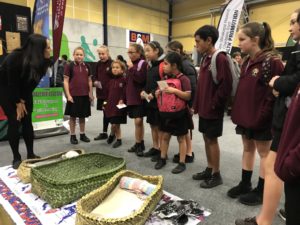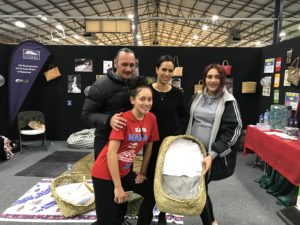Hāpai
The National SUDI Prevention Coordination team collaborated with Women’s Health Action (WHA), MidCentral DHB and Te Ohu Auahi Mutunga (TOAM) to hold a SUDI Prevention stall at Ngā Kapa Haka Kura Tuarua o Aotearoa. The event draws a large number of whānau from across Aotearoa and provides an occasion whereby intergenerational dialogue can occur about SUDI Prevention across whānau.
The space sought to provide a comfortable area for mothers to breastfeed and where tamariki, rangatahi and whānau could discuss current information relating to SUDI Prevention. The project gave the opportunity for a shared and collaborative approach across agencies where a stop smoking coach providing information on where to access help to quit and a lactation consultant offering information on breastfeeding support was on site to ensure whānau support services were readily available.
The Hāpai team used safe sleep messaging questionnaires to allow people to be in a draw to win a wahakura. The stall provided us with a great opportunity to engage with whānau Māori of all ages and backgrounds. We also met with many who are proactively weaving wahakura for their tamariki or mokopuna. It was really important for us to see how much the wahakura was valued, and it provided a strength based approach to discuss health promotion messaging with all.


Q: Is it safe to leave babies to sleep in car seats/capsules for extended periods of time as sometimes parents don’t want to wake baby after traveling?
Babies will often fall asleep in a car seat when travelling. Not surprisingly it is tempting to leave the baby asleep in the capsule when they arrive home. But is it safe? Studies of babies in car seats show that their head may flop forward and cause partial airway obstruction and hypoxia (low oxygen levels). This will briefly wake baby up (micro-arousals). Despite these concerns, SUDI in a car seat is rare. In the 3-year Nationwide SUDI Study there was only 1 death (out of 137) that occurred in a car seat. In comparison there were 7 control (living) babies (out of 249) in a car seat during the comparison sleep. This suggests it isn’t dangerous in healthy babies, but I would be concerned about repeated hypoxia in low tone babies, such as those with Down syndrome.Our SUDI Prevention Coordination service receives a lot of questions pertaining to a range of health related issues in context of infant and maternal wellbeing. To help answer these queries, we have approached Professor Ed Mitchell from our Expert Advisory Board to help provide context and insight for those interested and working in across the health sector.
Q: Should we be putting a hat on baby to sleep at night now it’s got cold?
Questions relating to type and amount of baby clothing are frequent. In the original New Zealand Cot Death Study (1987-1990) baby hats (e.g. beanies and bonnets) were used in 8.3% of cases and 5.2% of controls. In the Nationwide SUDI Study hats were used by 4.8% of cases and 3.9% of controls. These differences are small and not statistically significant. In infants the surface area of the head and neck is 20% of their total body area (compared with just 9% in adults). Heat loss can be considerable, so in cold conditions a hat will reduce this. This may prevent the baby getting cold and uncomfortable. But it doesn’t affect the risk of SUDI. Head covering increases the risk of SUDI, but this does not refer to hats; it refers to baby’s head being covered with blankets. A meta-analysis of 10 studies found the prevalence in cases was 24.6% and 3.2% among controls. This suggests head covering by blankets is a modifiable risk factor associated with SIDS deaths and has led to the UK recommendation to place baby at the foot of the bed (“Feet to foot”). Theoretically this might prevent babies kicking the blankets over their heads, but there isn’t much evidence to support that this happens, which is why we do not emphasise this in New Zealand.
Copyright © 2017 Hāpai Te Hauora, All rights reserved.
Our mailing address is:
hauora@hapai.co.nz